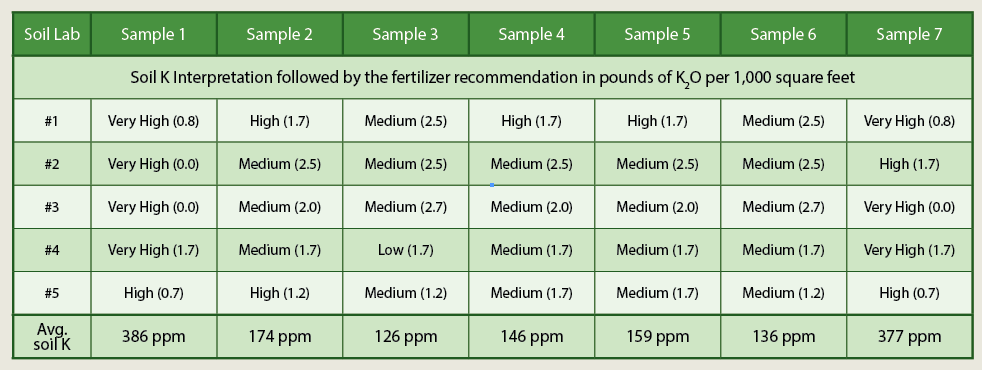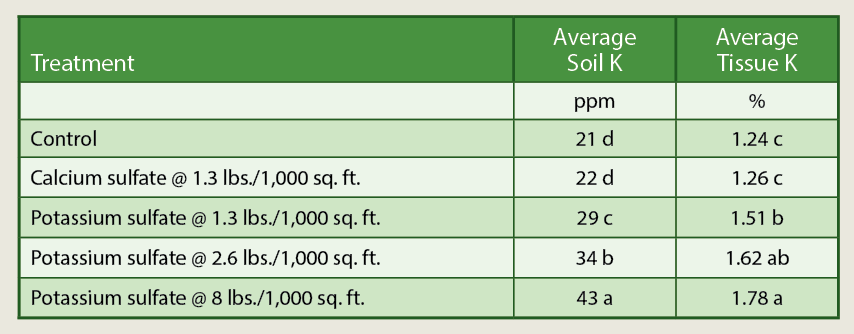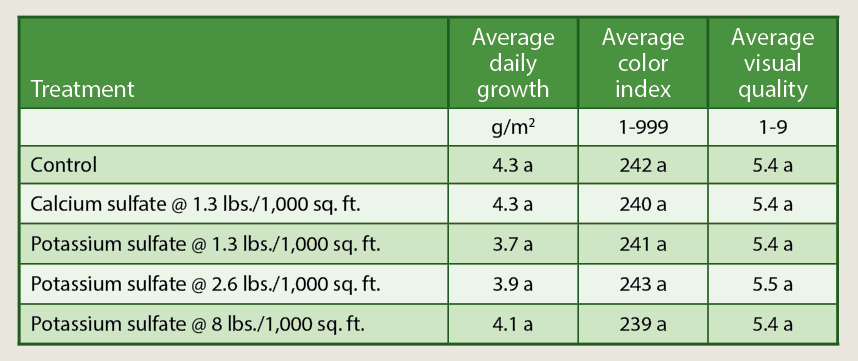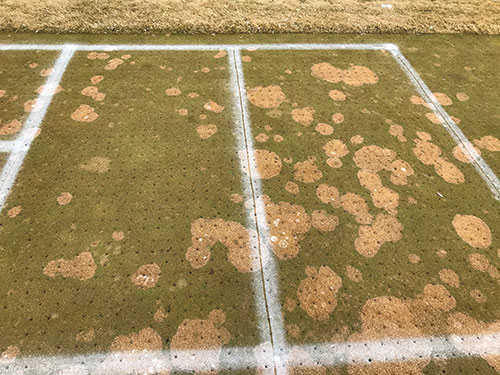Soil testing under the microscope
In the first chapter of the Soil Science Society of America’s 1990 book, “Soil Testing and Plant Analysis,” authors Peck and Soltanpour write that “Success or failure of soil testing varies depending upon the amount and quality of research data available for the calibration and interpretation of the tests.” Unfortunately, turfgrass scientists have not generated a large amount of research data useful for soil test calibration of turfgrass. As a result, soil nutrient interpretations and fertilizer recommendations are imprecise and of questionable accuracy.
The consequences of this lack of data have been recognized by turfgrass scientists for a long time. In 1978, Tom Turner and Don Waddington demonstrated the variability in soil test interpretation by sending soil samples to various turfgrass soil testing labs around the country. Each laboratory analyzed the same seven soil samples. There was relative agreement in the interpretation of the soil potassium (low, medium, high, etc.), as the labs were never more than one level away from one another, although they only were in total agreement for sample 6 (Table 1).

Table 1 Turner and Waddington’s (1978) survey of soil testing laboratories interpretations and recommendations for potassium fertilizer from turfgrass areas. Labs often agreed on the interpretation (low, medium, high, etc.) but varied widely in the amount of fertilizer recommended.
More interestingly, however, they saw a wide range of potassium fertilizer recommendations from the various laboratories. For example, sample 3 had the lowest soil K, and the fertilizer recommendations ranged from 1.2 pounds to 2.5 pounds of K2O per 1,000 square feet. Sample 6 had medium soil K, and the lab recommended the same 1.2 pounds to 2.5 pounds of K2O per 1,000 square feet. Sample 1 had the greatest amount of soil K, and the interpretations ranged from 0 pounds to 1.7 pounds of K2O per 1,000 square feet. Lab No. 5 (see table) is particularly interesting because it recommended 1.7 pounds of K2O per 1,000 square feet for each of the seven samples, regardless of whether the soil K was reported low or extremely high. What is the point of soil testing if the fertilizer recommendation doesn’t depend on the result?
Laboratories didn’t agree on soil test interpretation 40 years ago, and they still don’t agree today. Researchers are working to change that by continuing to study how soil nutrient levels affect grass growth, but progress is slow. This article describes the results of a soil test calibration study for potassium on creeping bentgrass grown on a sand root zone.
A continuing study
In 2011, a project was initiated — and continues in 2017 — at the O.J. Noer Turfgrass Research Facility in Madison, Wis., on a USGA putting green with A4 creeping bentgrass (Agrostis stolonifera L.). The treatments include five levels of liquid potassium sulfate at rates ranging from 0 pounds to 0.6 pounds of K2O per 1,000 square feet every two weeks (approximately 0 pounds to 8 pounds K2O per 1,000 square feet annually, depending on the exact start and stop dates of the applications). Urea is spoon-fed throughout the season for an annual total of about 2 pounds of nitrogen per 1,000 square feet.
Plant tissue samples are collected monthly to measure clipping yield and tissue K content. Soil samples also are taken monthly to a depth of 3 inches and analyzed for plant-available nutrients using the Mehlich-3 method. Turfgrass color index is evaluated every two weeks using a reflectance meter that measures wavelengths corresponding to chlorophyll reflectance (CM-1000, Spectrum Technologies). Visual turfgrass quality also is evaluated every two weeks using the standard National Turfgrass Evaluation Program rating scale of 1-9, where 1 represents completely brown or dead turf, 6 represents the minimally acceptable turf quality and 9 represents the greatest possible quality. We use a golf cart traffic simulator six times per week to create wear stress on the plots, as potassium has been associated with wear tolerance in the past. Wear traffic was not applied in 2016 because of mechanical failure of the simulator.
Finally, because we were interested in how potassium affects common diseases, we apply fungicides only rarely, usually in cases where we are concerned about losing the entire stand. Disease incidence is quantified by counting infection centers, visual percentage estimation, and by the grid intersection method, where we place an 81-point grid on the plot and the presence/absence of the disease is recorded directly under each intersection.
When the results get interesting

Table 2 The treatments employed in this study created a range in Mehlich-3 soil K and tissue K content. Different letters within columns indicate statistically significant differences according to Fisher’s protected LSD0.05.
By treating the grass with different levels of potassium fertilizer, we create fairly large differences in soil and tissue levels across the treatments (Table 2). Despite this wide range in potassium availability over the study period, little has happened to the turf. Averaged over six years, turfgrass color index, visual quality and clipping yield are all statistically similar for all treatments (Table 3).

Table 3 The treatments have not created significant differences in growth, color, or quality when averaged over the study period. Different letters within columns indicate statistically significant differences according to Fisher’s protected LSD0.05.
In short, adding potassium has not made the grass any greener, denser or faster growing. We’re not saying that potassium isn’t required. It simply means that we have not found the soil level at which problems become evident for this situation. The treatments that do not receive potassium fertilizer average about 20 ppm soil K (on the Mehlich-3 test), while the highest rate has reached an average of 43 ppm soil K.
However, in about two months of the year — March and April — this study gets interesting.

Table 4 The treatments resulted in significant differences in pink snow mold (or microdochium patch). Different letters within columns indicate statistically significant differences according to Fisher’s protected LSD0.05.
Beginning in 2014, we noticed differences in pink snow mold among the treatments. The snow mold was more severe on treatments that received potassium, and lower on non-fertilized treatments. We’ve observed this effect each year, and each year has produced more snow mold pressure than the last (Table 4). The differences in snow mold damage are striking, and they’re shown in Figure 1.

Figure 1 The plot on the left has not received potassium for the past six years. The plot on the right has received 1.3 pounds of K2O/1000 square feet annually during that period. The grass type is ‘A4’ creeping bentgrass maintained as a putting green on a sand-based root zone.
I am not familiar with another nutrient where high levels are so clearly associated with a negative impact, except for nitrogen, which we know can exacerbate biotic and abiotic stresses when over-applied. Ours also is not the first study to report increased snow mold damage associated with potassium fertilizers. Researchers at Cornell University and the University of Massachusetts reported increased incidence of gray snow mold with increasing potassium fertilization.
Potassium often is thought of as a stress nutrient. It has been implicated in traffic stress, heat stress, cold stress and disease stress. I believe that this has led to the over-application of potassium fertilizers. Our work suggests that there may be negative consequences of excess potassium beyond the time and money wasted when an excess of the required minimum nutrient is applied.
Some have expressed indifference to these results because of the well-documented ability of fungicides to control snow mold disease. But a time may come when pesticide restrictions force managers to rely on ecological and cultural tools alone to manage pests. The more information we have, the better prepared we’ll be.
It’s important to highlight the specificity of these results to creeping bentgrass. Researchers at Rutgers have clearly documented that low potassium levels can result in increased winterkill and summer anthracnose damage to annual bluegrass (Poa annua L.). This is the frustrating aspect of soil test calibration work — the results may differ from one grass to the next, which further complicates the interpretation of soil tests.
However, on the bright side, I think these differing results have provided an opportunity to use potassium to manage for the type of grass that we want to maintain. If a golf course superintendent has a pure stand of creeping bentgrass, keeping potassium levels low may be a good strategy to keep annual bluegrass from invading. On the other hand, a manager with primarily annual bluegrass should use the latest data to make sure the potassium requirements of annual bluegrass are being met to minimize anthracnose and winterkill.
Less potassium than expected
This study sheds light on potassium requirements of creeping bentgrass grown on sand root zones. The amount of potassium required to maintain healthy bentgrass appears much lower than previously thought. Table 1 illustrates that the lowest sample was near 126 ppm, considered to be between medium or low in potassium. We are finding that superintendents can grow healthy creeping bentgrass on sand with as low as 20 ppm soil K. This is substantially lower than even the lowest current recommendation (Pace Turf’s Minimum Levels for Sustainable Nutrition recommends keeping potassium at or above 42 ppm).
However, we know that potassium requirements depend on soil type and the grass species being grown. So, while I am confident that you can grow good creeping bentgrass with Mehlich-3 levels around 20 ppm on sand like ours, it’s likely that the soil requirements would be different for annual bluegrass or bermudagrass (Cynodon sp.), etc. Please continue to support and encourage soil test calibration research as we continually work toward a greater understanding of the soil levels required to satisfy the varied turfgrass nutritional requirements.
References
Peck, T.R., and P.N. Soltanpour. 1990. The principles of soil testing. P. 1-8. In R.L. Westerman et al. (ed.) Soil testing and plant analysis. ASA, CSSA, and SSSA, Madison, WI. Schmid, C.J., J.A.
Murphy, B.B. Clarke, M. DaCosta, and J.S. Ebdon. 2016. Observations on the effect of potassium on winter injury of annual bluegrass in New Jersey in 2015. Crop, Forage & Turfgrass Management. DOI: 10.2134/cftm2015.0170.
Turner, T.R. and D.V. Waddington. 1978. Survey of soil testing programs for turfgrasses. Communications in Soil Science and Plant Analysis. 9:71-87.
Webster, D.E., and J.S. Ebdon. 2005. Effects of nitrogen and potassium fertilization on perennial ryegrass cold tolerance during deacclimation in late winter and early spring. HortScience. 40:842-849.
Woods, M.S., Q.M. Ketterings, F.S. Rossi, and A.M. Petrovic. 2006. Potassium availability indices and turfgrass performance in a calcareous sand putting green. Crop Science. 46:381-389.
Photo: Doug Soldat, Ph.D.








